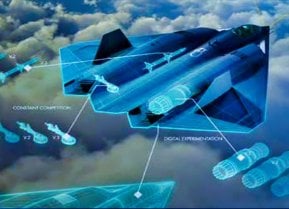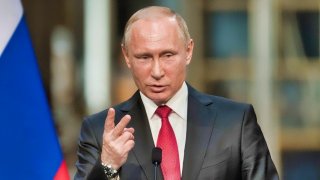Putin Isn't Bluffing: The Ukraine Was Is Slowly Becoming a Global War
The ongoing conflict in Ukraine has expanded its implications globally, with recent Russian naval maneuvers in the Baltic Sea and near American shores.
Summary and Key Points: The ongoing conflict in Ukraine has expanded its implications globally, with recent Russian naval maneuvers in the Baltic Sea and near American shores.
-Russia's deployment of diesel-electric submarines in the Baltic for anti-submarine exercises and the movement of a nuclear submarine near Florida en route to Cuba signal Moscow's assertiveness. These actions suggest a broader strategy to challenge NATO's dominance and potentially support Venezuela's ambitions against Guyana.
-The use of stealthy diesel-electric submarines highlights Russia's capability to complicate NATO's maritime operations. The situation underscores the long-term consequences of NATO expansion, which Russia perceives as a threat, contributing to the current global tensions.
The Ukraine War Goes Global: Russia’s Naval Movements in the Baltic Sea and Cuba
In what reminds many of the hottest moments of the Cold War that defined the back half of the twentieth century, the Russian Navy deployed two of its “cutting edge” diesel-electric submarines, Novorossiysk and Dmitrov, to the Baltic Sea. There, they engaged in “anti-submarine maneuvers” in which the two crews practiced firing torpedoes at each other.
This move comes on the heels of a jarring incident in which a Russian nuclear submarine carrying advanced hypersonic weapons popped-up near American shores on its way to Cuba.
For its part, Washington and its allies downplayed the latter incident, despite deploying a joint flotilla of U.S. and Canadian Navy warships to shadow the Russian fleet as it transited near Florida’s coast on its way to Cuba.
The Baltic Sea incident involving the two Russian diesel-electric submarines is a stark reminder that the world we are living in is far removed from the world as it was even just two years ago, before the Russian invasion of Ukraine.
Russia Making Bold Moves In the World
While the Russians, even in the doldrums of the decade immediately following the collapse of the Soviet Union, did conduct military drills and attempted to maintain whatever fighting edge they could, the recent drills in the Baltic and the movement of their naval forces to Cuba is something more. My colleague, Evan Ellis of the Army War College, has written extensively about the truth behind Russia’s maritime movements to Cuba.
Sure, it was to show the Americans that whatever the Yanks could do in Russia’s backyard, Moscow could do it in America’s backyard. Reciprocity is, after all, a key tenet of international relations. Then again, Ellis argues, the Russian fleet movements to Cuba were planned well in advance of their deployment and represent something more.
On his Substack, Ellis postulates that the Russian warship movements to Cuba are about backing up whatever military action Venezuela is planning against their oil-rich neighbor of Guyana. Washington, in typical fashion, is unaware of the truth of these movements (or more probably is in denial about their significance). But the movements of Russia’s navy should not be discounted.
Because the world we are in is not the unipolar world order that so many of us enjoyed our formative years in.
As for the Russian submarine drills in the Baltic Sea, it represents a signal from Moscow to Washington and Brussels: We are nearby and we are not a paper tiger. The Baltic Sea has often been described – or taken for granted – as a “NATO lake.” In fact, however, the Russians have multiple capabilities to complicate life for the combined navies of NATO member-states in regions close to Russia, such as the Baltic Sea.
Short of a direct war between NATO and Russia, one should anticipate these exercises displayed by Russian submarines are the start rather than the end of significant escalations.
Why Diesel-Electric Submarines are a Problem for NATO
A key element for understanding the move by Russia in the Baltic is the fact that they deployed diesel-electric subs. This is an important aspect because the diesel-electric submarine, despite being an older system compared to nuclear-powered subs, has proven itself difficult to track.
We’ve seen in the past how older, diesel-powered submarines operating in the Indo-Pacific, have managed to surprise U.S. Navy warships, such as during the 2007 event in which an antique Chinese navy diesel sub got within firing range of the USS Kitty Hawk aircraft carrier. There have been other instances wherein diesel-electric subs, such as Gotland, defeated American surface warships in military exercises conducted between the U.S. Navy and allied powers.
The Navy claims these instances are the exception to the rule. Let us hope they are. Personally, one should avoid trying to find out in the crucible of war. Should conflict between NATO and Russia erupt over the fate of Ukraine, the Baltic Sea will be a major flashpoint, and Russia’s recent testing of systems, such as their diesel-electric submarines, are an indicator that they will endeavor to deny NATO the maritime dominance that Brussels assumes it’ll enjoy there.
Elsewhere, the global nature of the Ukraine War is felt with the presence of that Russian flotilla in Cuba. Sure, the U.S. Navy could probably knock that Russian fleet out. But at what cost? Surely, the Russians will not simply accept the loss of these warships in combat without risking wider escalation—possibly with nukes?
And if the Americans ignore the Russian naval threat in our own hemisphere, then, when the Venezuelan regime opts to invade Guyana, the Russians will have free range to help the embattled Venezuelan government take what they want.
NATO Expansion is to Blame
All this because the Americans for years suborned the expansion of a NATO alliance that was increasingly viewed as a direct threat to the Russian Federation. At a time when comity with Russia should have been the primary policy, Washington pursued a bizarre dual-track program intended to placate a weakened, post-Soviet Russia while simultaneously allowing for multiple rounds of NATO expansion.
This, more than anything, has helped to both prompt the Russian invasion of Ukraine as well as to ensure that what should be a minor regional war that has nothing to do with the national security interests of the United States instead became a major global conflict.
One can anticipate more aggressive posturing from Russia both in the Baltic and elsewhere. Possibly against Japan over the Kuril Islands, likely in South America, and potentially throughout Africa.
None of which was inevitable in the 1990s.
Author Experience and Expertise: Brandon J. Weichert
Brandon J. Weichert, a National Interest national security analyst, is a former Congressional staffer and geopolitical analyst who is a contributor at The Washington Times, the Asia Times, and The-Pipeline. He is the author of Winning Space: How America Remains a Superpower, Biohacked: China’s Race to Control Life, and The Shadow War: Iran’s Quest for Supremacy. His next book, A Disaster of Our Own Making: How the West Lost Ukraine, is due October 22 from Encounter Books. Weichert can be followed via Twitter @WeTheBrandon.
All images are Creative Commons or Shutterstock.
From the Vault
Russia Freaked Out: Why the U.S. Navy 'Unretired' the Iowa-Class Battleships
Battleship vs. Battlecruiser: Iowa-Class vs. Russia's Kirov-Class (Who Wins?)


